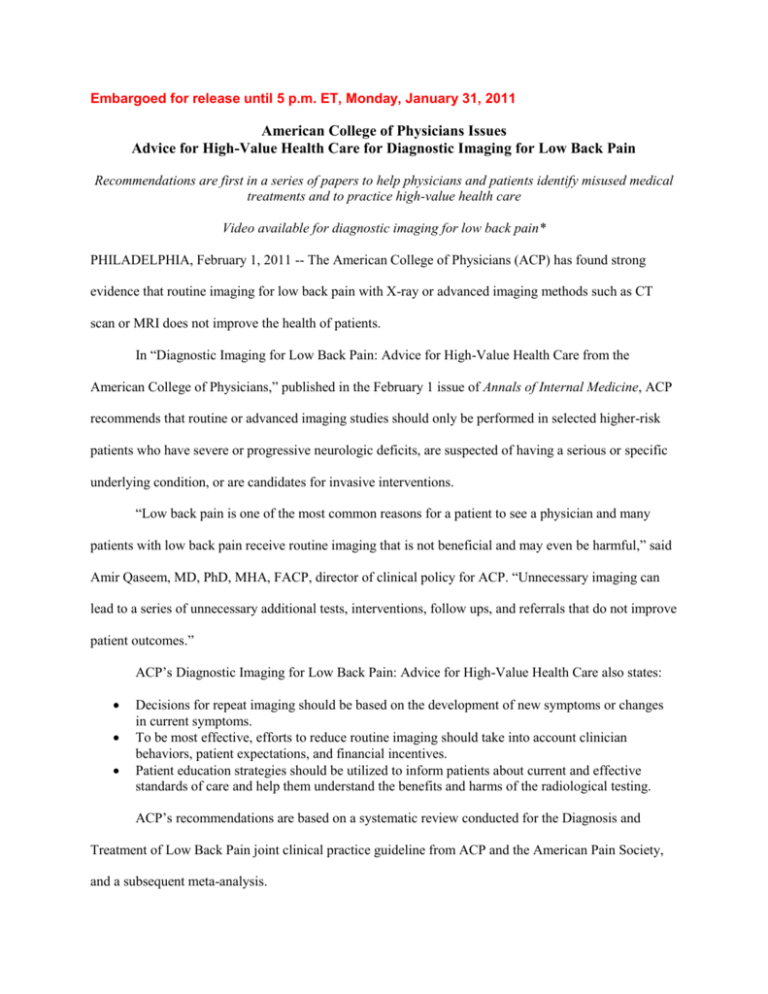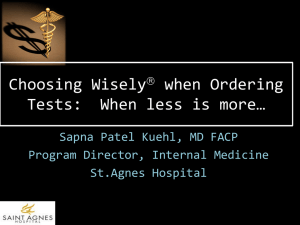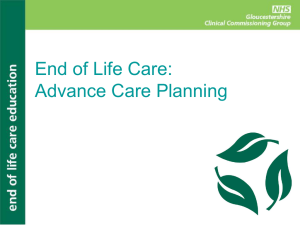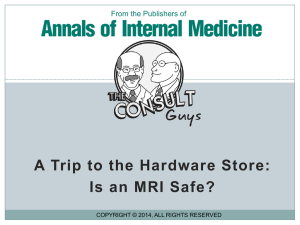Press Release
advertisement

Embargoed for release until 5 p.m. ET, Monday, January 31, 2011 American College of Physicians Issues Advice for High-Value Health Care for Diagnostic Imaging for Low Back Pain Recommendations are first in a series of papers to help physicians and patients identify misused medical treatments and to practice high-value health care Video available for diagnostic imaging for low back pain* PHILADELPHIA, February 1, 2011 -- The American College of Physicians (ACP) has found strong evidence that routine imaging for low back pain with X-ray or advanced imaging methods such as CT scan or MRI does not improve the health of patients. In “Diagnostic Imaging for Low Back Pain: Advice for High-Value Health Care from the American College of Physicians,” published in the February 1 issue of Annals of Internal Medicine, ACP recommends that routine or advanced imaging studies should only be performed in selected higher-risk patients who have severe or progressive neurologic deficits, are suspected of having a serious or specific underlying condition, or are candidates for invasive interventions. “Low back pain is one of the most common reasons for a patient to see a physician and many patients with low back pain receive routine imaging that is not beneficial and may even be harmful,” said Amir Qaseem, MD, PhD, MHA, FACP, director of clinical policy for ACP. “Unnecessary imaging can lead to a series of unnecessary additional tests, interventions, follow ups, and referrals that do not improve patient outcomes.” ACP’s Diagnostic Imaging for Low Back Pain: Advice for High-Value Health Care also states: Decisions for repeat imaging should be based on the development of new symptoms or changes in current symptoms. To be most effective, efforts to reduce routine imaging should take into account clinician behaviors, patient expectations, and financial incentives. Patient education strategies should be utilized to inform patients about current and effective standards of care and help them understand the benefits and harms of the radiological testing. ACP’s recommendations are based on a systematic review conducted for the Diagnosis and Treatment of Low Back Pain joint clinical practice guideline from ACP and the American Pain Society, and a subsequent meta-analysis. Preserving High-Value, High-Quality Care In a related paper, “High-Value, Cost-Conscious Health Care: Concepts for Clinicians to Evaluate the Benefits, Harms, and Costs of Medical Interventions,” also published in the February 1 issue of Annals, ACP explains the purpose of its Advice for High-Value Health Care series: to slow the unsustainable rate of health care costs while preserving high-value, high-quality care. “Efforts to control expenditures should not focus solely on the costs, but rather on the value of health-care interventions,” said co-author Paul Shekelle, MD, PhD, FACP, chair of ACP's Clinical Guidelines Committee. “The best way to maintain effective and efficient care is to identify and eliminate wasteful practices, and to demonstrate which interventions provide high-value, which means their benefit is sufficient to justify their harms and costs.” The distinction between cost and value (an assessment of whether an intervention provides health benefits, does have acceptable level of harms, and is worth what it costs) is critical, ACP says; high-cost interventions may provide good value because the benefits may be large and therefore justify the harms and costs. Conversely, low-cost interventions may be of little or no value if they provide little benefit. In the paper, ACP outlines three key concepts necessary for understanding how to assess the value of health-care interventions: It is essential to assess the benefits, harms, and costs of an intervention to understand whether it provides good value. It is important to reduce the use of interventions that provide no benefit. Assessment of the cost of an intervention should include not only the cost of the intervention itself, but also any downstream costs that occur because the intervention was performed. The incremental cost-effectiveness ratio estimates how much additional cost is required to obtain additional health benefit, and provides a key measure of the value of a health care intervention. Health benefit can be measured in many ways, including cases detected or averted, life years gained, or quality-adjusted life years gained. For interventions that provide additional benefit at additional cost, ACP recommends assessing their value to patients and society with cost-effectiveness analysis. Additional Resources: Diagnostic Imaging for Low Back Pain: Advice for High-Value Health Care from ACP and Patient Summary HEALTH TiP from ACP Foundation High-Value, Cost-Conscious Health Care: Concepts for Clinicians to Evaluate the Benefits, Harms, and Costs of Medical Interventions and Patient Summary How Can Our Nation Conserve and Distribute Health Care Resources Effectively and Efficiently? ACP Announces High-Value, Cost-Conscious Care Initiative About the American College of Physicians The American College of Physicians is the largest medical specialty organization and the second-largest physician group in the United States. ACP members include 130,000 internal medicine physicians (internists), related subspecialists, and medical students. Internists specialize in the prevention, detection, and treatment of illness in adults. Follow ACP on Twitter and Facebook. ### * Satellite Feed Dates, Times, and Coordinates for "Diagnostic Imaging for Low Back Pain" Video News Story Date: Monday, January 31, 2011 Time: 10:30 AM - 10:45 AM Eastern; 9:30 AM - 9:45 AM Central; 8:30 AM - 8:45 AM Mountain; 7:30 AM - 7:45 AM Pacific C-Band Satellite: AMC 1 Transponder: 9 Downlink: 3880 (H) Audio: 6.2 & 6.8 Date: Monday, January 31, 2011 Time: 2:00 PM - 2:15 PM Eastern; 1:00 PM - 1:15 PM Central; 12:00 PM - 12:15 PM Mountain; 11:00 AM - 11:15 AM Pacific C-Band Satellite: AMC 1 Transponder: 9 Downlink: 3880 (H) Audio: 6.2 & 6.8 Date: Tuesday, February 1, 2011 Time: 1:30 PM - 1:45 PM Eastern; 12:30 PM - 12:45 PM Central; 11:30 AM - 11:45 AM Mountain; 10:30 AM - 10:45 AM Pacific C-Band Satellite: AMC 1 Transponder: 9 Downlink: 3880 (H) Audio: 6.2 & 6.8 This story is available on the Pathfire DMG on the News/Video News Feeds Section at D S Simon Productions Tab: Medical Story Slug: Low back pain guidelines Story Number: ACP65 To view the video, obtain a copy of press materials or script, or request a hard copy tape, please go to http://media.dssimon.com/acp65.









